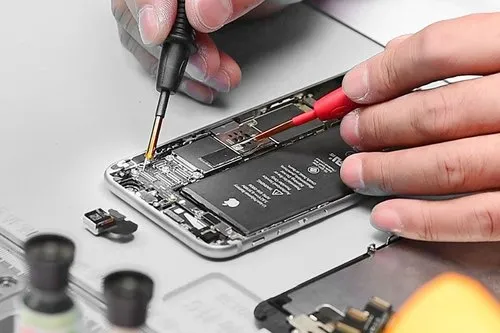A cracked iPhone tends to show up at the worst time. You can still tap out a message, yet every swipe feels risky. Glass splinters, touch glitches, and battery drain may follow. Many people try to get by for a while, hoping the damage stays cosmetic. Others worry about hidden faults that might later turn a small job into a costly iPhone repair.

This guide describes what usually remains usable, what might fail, and how to decide your next step. The goal is simple. Help you protect your data, your fingers, and your wallet.
Can a Smashed iPhone Still Be Used?
Short answer. Sometimes. Usability depends on the scope of damage and the functions you rely on each day. From a practical standpoint, a cracked panel is a safety and reliability issue rather than only an appearance issue. Auckland Tech Experts suggest that friction, glare, and visual clutter increase error rates, which may be why cracked screens often feel slower even when the processor is fine. In repair practice, technicians treat a smash as a systems problem that could affect glass, digitiser, display, chassis alignment, and water resistance.
Check the following for self-diagnostics:
- Test the touch grid in a few places. Soft touches, hard taps, and swipes from the edges.
- Inspect for coloured lines, black spots, or flicker. These are frequently visual indications of a display or connector stress.
- Check the Face ID, Touch ID, and the selfie camera. Microcracks near the sensors are one possible cause of this.
- Test to see if the calls answer on both the earpiece and the speaker. The opening on top may let the dust into the mesh.
- Take a backup immediately. A local backup to a computer or a cloud backup reduces the stress of later failures.
- Apply a temporary screen protector to reduce glass flake. A simple case helps prevent torsion.
- Avoid moisture. Even light rain can wick through cracked glass and compromise the seal.
If the device passes touch and display tests, you may keep using it briefly. Yet there is a credible risk that vibration, heat, or mild impact could expand the fault. You are trading near-term convenience for a possible jump in cost if damage spreads to the logic board or cameras.
Common Doubts and How To Think Through Them
People often ask whether a crack that still allows normal use will harm internal components. It might. Glass fragments can grind against the digitiser, and small gaps invite moisture and fine dust. Over weeks, this can increase the likelihood of ghost touches or corrosion. Another question that pops up is about data loss. Screen destruction won’t erase your data. However, if the display or touch fails suddenly, you may lose easy access. That is why a verified backup is the first priority rather than an afterthought.
There is lively debate in the repair community about original parts and aftermarket options. Some argue that only OEM parts preserve calibration and colour accuracy. Others note that high-grade third-party panels can be serviceable when sourced carefully and installed with correct adhesive and frame prep. It’s better to look at warranty terms and the technician’s track record rather than labels alone. Battery safety is similar. A physically stressed phone may show faster drain because background sensors fight with damaged components. Replacing a screen while ignoring a swollen or aged battery can lead to recurring issues.
People are also concerned that a fix will nullify support. The policies differ by location and previous service. The sensible approach is to document the condition, read warranty language carefully, and ask around; shopkeepers who can clearly communicate what they know about diagnostics, parts, and aftercare are a promising find. If you rely on the device for work or school, then factor in the cost of downtime. A same-day fix, reinstating touch accuracy and weather protection, can be cheaper than weeks of slow tasks and frequent drops.
iPhone Repair Auckland: Why Local Expertise Matters
For fast, reliable help, 73inc offers iPhone repairs in Auckland with a careful, data-first workflow. The team begins with a structured diagnostic to confirm whether only the screen is affected or if the cameras, speakers, or frame also need attention. That saves time and avoids repeat visits. You get clear options, including part quality choices, expected colour accuracy, and warranty details. Installations follow best practice for adhesive curing and seal renewal, which supports everyday splash resistance in normal use.
Most fixes are done the same day, and you can ask about backup checks if you’re unsure of your iCloud status. If your case involves more than a simple crack, 73inc explains the trade-offs so you can confidently decide. Friendly service, plain language, and local accountability make a difference when your phone cannot wait.
Conclusion
So, can a smashed iPhone still be used? In limited situations, the answer is yes. The smart move is to make a backup, assess touch and display health, and avoid moisture. If you notice spreading cracks, ghost input, or camera haze, a prompt repair will likely reduce total cost. Choosing a trusted local provider brings that approach within reach.
If you are in Auckland and want clear guidance with quick turnaround, visit 73inc for iPhone Repairs Auckland and get a calm plan that suits your day. Book a swift diagnostic, restore smooth taps and clean visuals, and carry on with confidence.


